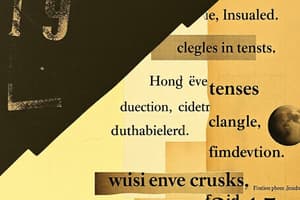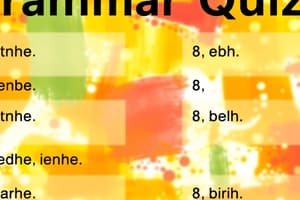Podcast
Questions and Answers
What type of tense is used in the sentence 'She has been walking to school.'?
What type of tense is used in the sentence 'She has been walking to school.'?
- Present Perfect Continuous (correct)
- Future Simple
- Past Continuous
- Present Simple
Which part of speech is the word 'quickly' in the sentence 'She runs quickly'?
Which part of speech is the word 'quickly' in the sentence 'She runs quickly'?
- Noun
- Adverb (correct)
- Adjective
- Verb
What type of verb is 'is' in the sentence 'He is happy.'?
What type of verb is 'is' in the sentence 'He is happy.'?
- Action verb
- Intransitive verb
- Transitive verb
- Linking verb (correct)
Which example correctly illustrates a dependent clause?
Which example correctly illustrates a dependent clause?
In the sentence 'She will have walked to school by 8 AM,' which type of tense is used?
In the sentence 'She will have walked to school by 8 AM,' which type of tense is used?
What does the simple present tense primarily describe?
What does the simple present tense primarily describe?
Which of the following sentences contains an adjective clause?
Which of the following sentences contains an adjective clause?
Which of the following is an example of a noun?
Which of the following is an example of a noun?
In the sentence 'I had been walking to school when it started to rain,' which type of past tense is used?
In the sentence 'I had been walking to school when it started to rain,' which type of past tense is used?
Which of the following words is an example of a conjunction?
Which of the following words is an example of a conjunction?
Flashcards are hidden until you start studying
Study Notes
Tenses Usage
-
Present Tense
- Simple: Describes habitual actions or general truths (e.g., "She walks to school.").
- Continuous: Ongoing actions happening now (e.g., "She is walking to school.").
- Perfect: Completed actions with relevance to the present (e.g., "She has walked to school.").
- Perfect Continuous: Ongoing actions that started in the past and continue to the present (e.g., "She has been walking to school.").
-
Past Tense
- Simple: Completed actions in the past (e.g., "She walked to school.").
- Continuous: Ongoing actions in the past (e.g., "She was walking to school.").
- Perfect: Actions completed before another past action (e.g., "She had walked to school.").
- Perfect Continuous: Ongoing past actions that were completed before another past action (e.g., "She had been walking to school.").
-
Future Tense
- Simple: Actions that will happen (e.g., "She will walk to school.").
- Continuous: Ongoing actions that will occur in the future (e.g., "She will be walking to school.").
- Perfect: Actions that will be completed before a specific point in the future (e.g., "She will have walked to school.").
- Perfect Continuous: Ongoing actions that will continue up to a certain point in the future (e.g., "She will have been walking to school.").
Parts of Speech
- Noun
- Names a person, place, thing, or idea (e.g., "dog," "city," "freedom").
- Pronoun
- Replaces a noun (e.g., "he," "they," "it").
- Verb
- Expresses action or state of being (e.g., "run," "is," "become").
- Adjective
- Describes a noun or pronoun (e.g., "happy," "blue," "tall").
- Adverb
- Modifies a verb, adjective, or other adverb (e.g., "quickly," "very," "well").
- Preposition
- Shows the relationship between a noun (or pronoun) and other words (e.g., "in," "on," "at").
- Conjunction
- Connects words, phrases, or clauses (e.g., "and," "but," "or").
- Interjection
- Expresses strong emotion (e.g., "Wow!," "Oh no!").
Clauses
-
Independent Clause
- A complete thought that can stand alone as a sentence (e.g., "I enjoy reading.").
-
Dependent Clause
- Cannot stand alone and depends on an independent clause (e.g., "Because I enjoy reading…").
-
Types of Clauses
- Noun Clause: Functions as a noun (e.g., "What you said was surprising.").
- Adjective Clause: Modifies a noun (e.g., "The book that I read was fascinating.").
- Adverb Clause: Modifies a verb, adjective, or adverb (e.g., "I left because it was late.").
-
Subordinating Conjunctions
- Introduce dependent clauses (e.g., "although," "since," "unless").
Tenses Usage
-
Present Tense
- Simple presents habitual actions or general truths (e.g., "She walks to school").
- Continuous indicates actions happening right now (e.g., "She is walking to school").
- Perfect shows completed actions relevant to the present (e.g., "She has walked to school").
- Perfect Continuous describes ongoing actions that started in the past and continue (e.g., "She has been walking to school").
-
Past Tense
- Simple refers to actions completed in the past (e.g., "She walked to school").
- Continuous indicates actions that were ongoing in the past (e.g., "She was walking to school").
- Perfect highlights actions completed before another past action (e.g., "She had walked to school").
- Perfect Continuous refers to ongoing past actions completed before another past event (e.g., "She had been walking to school").
-
Future Tense
- Simple denotes actions that will occur (e.g., "She will walk to school").
- Continuous indicates ongoing actions that will happen in the future (e.g., "She will be walking to school").
- Perfect describes actions that will be completed before a specific future point (e.g., "She will have walked to school").
- Perfect Continuous denotes ongoing actions continuing up to a certain future point (e.g., "She will have been walking to school").
Parts of Speech
-
Noun
- Represents a person, place, thing, or idea (e.g., "dog," "city," "freedom").
-
Pronoun
- Replaces a noun to avoid repetition (e.g., "he," "they," "it").
-
Verb
- Indicates action or state of being (e.g., "run," "is," "become").
-
Adjective
- Describes or modifies a noun or pronoun (e.g., "happy," "blue," "tall").
-
Adverb
- Modifies verbs, adjectives, or other adverbs (e.g., "quickly," "very," "well").
-
Preposition
- Shows the relationship between a noun (or pronoun) and other words (e.g., "in," "on," "at").
-
Conjunction
- Connects words, phrases, or clauses (e.g., "and," "but," "or").
-
Interjection
- Expresses strong emotion (e.g., "Wow!," "Oh no!").
Clauses
-
Independent Clause
- A complete thought, capable of standing alone as a sentence (e.g., "I enjoy reading").
-
Dependent Clause
- Lacks a complete thought and relies on an independent clause (e.g., "Because I enjoy reading…").
-
Types of Clauses
- Noun Clause: Functions as a noun (e.g., "What you said was surprising").
- Adjective Clause: Modifies a noun (e.g., "The book that I read was fascinating").
- Adverb Clause: Modifies a verb, adjective, or adverb (e.g., "I left because it was late").
-
Subordinating Conjunctions
- Words that introduce dependent clauses (e.g., "although," "since," "unless").
Studying That Suits You
Use AI to generate personalized quizzes and flashcards to suit your learning preferences.




